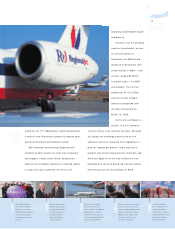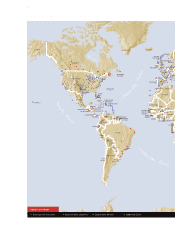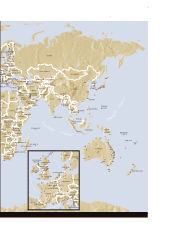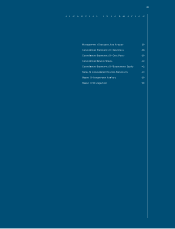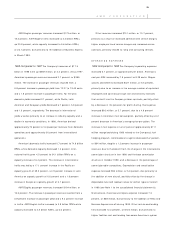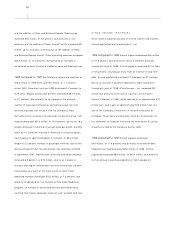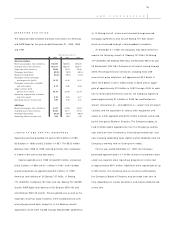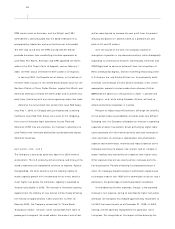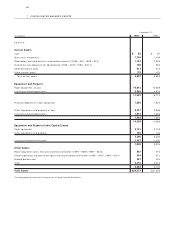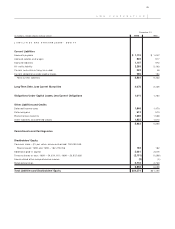American Airlines 1999 Annual Report Download - page 32
Download and view the complete annual report
Please find page 32 of the 1999 American Airlines annual report below. You can navigate through the pages in the report by either clicking on the pages listed below, or by using the keyword search tool below to find specific information within the annual report.
AMR CORPORATION
31
OPERATING STATI STI CS
The following table provides statistical information for American
and AMR Eagle for the years ended December 31, 1999, 1998
and 1997.
Year Ended December 31,
1999 1998 1997
American Airlines
Revenue passenger miles (millions) 112,067 108,955 107,026
Available seat miles (millions) 161,211 155,297 153,917
Cargo ton miles (millions) 2,068 1,974 2,032
Passenger load factor 69.5% 70.2% 69.5%
Breakeven load factor 63.8% 59.9% 61.0%
Passenger revenue yield per
passenger mile (cents) 13.12 13.49 13.37
Passenger revenue per available
seat mile (cents) 9.12 9.46 9.30
Cargo revenue yield
per ton mile (cents) 30.70 32.85 33.78
Operating expenses per available
seat mile (cents) 9.39 9.25 9.27
Operating aircraft at year-end 697 648 641
AM R Eagle
Revenue passenger miles (millions) 3,371 2,788 2,553
Available seat miles (millions) 5,640 4,471 4,218
Passenger load factor 59.8% 62.4% 60.5%
Operating aircraft at year-end 268 209 199
LI QUIDI TY AND CAPI TAL RESOURCES
Operating activities provided net cash of $2.3 billion in 1999,
$2.8 billion in 1998 and $2.5 billion in 1997. The $533 million
decrease from 1998 to 1999 resulted primarily from a decrease
in income from continuing operations.
Capital expenditures in 1999 totaled $3.5 billion, compared
to $2.3 billion in 1998 and $1.1 billion in 1997, and included
aircraft acquisitions of approximately $2.7 billion. In 1999,
American took delivery of 24 Boeing 737-800s, 11 Boeing
777-200IGWs, six Boeing 757-200s and four Boeing 767-300ER
aircraft. AMR Eagle took delivery of 25 Embraer ERJ-145s and
nine Embraer ERJ-135 aircraft. These expenditures, as well as the
expansion of certain airport facilities, were funded primarily with
internally generated cash, except for (i) the Embraer aircraft
acquisitions, which were funded through secured debt agreements,
(ii) 14 Boeing aircraft, which were financed through secured
mortgage agreements, and (iii) one Boeing 757-200 aircraft,
which was financed through a sale-leaseback transaction.
At December 31, 1999, the Company had commitments to
acquire the following aircraft: 81 Boeing 737-800s, 26 Boeing
777-200IGWs, 86 Embraer ERJ-135s, five Embraer ERJ-145s and
25 Bombardier CRJ-700s. Deliveries of all aircraft extend through
2006. Future payments for all aircraft, including estimated
amounts for price escalation, will approximate $2.2 billion in
2000, $1.8 billion in 2001, $600 million in 2002 and an aggre-
gate of approximately $1.0 billion in 2003 through 2006. In addi-
tion to these commitments for aircraft, the Company expects to
spend approximately $1.6 billion in 2000 for modifications to
aircraft, renovations of – and additions to – airport and off-airport
facilities, and the acquisition of various other equipment and
assets, of which approximately $470 million has been authorized
by the Company’s Board of Directors. The Company expects to
fund its 2000 capital expenditures from the Company’s existing
cash and short-term investments, internally generated cash, and
new financing depending upon capital market conditions and the
Company’s evolving view of its long-term needs.
For the year ended December 31, 1999, the Company
purchased approximately 14.1 million shares of its common stock
under two separate share repurchase programs at a total cost
of approximately $871 million. Additional share repurchases of up
to $34 million, the remaining amount currently authorized by
the Company’s Board of Directors, may be made from time to
time, depending on market conditions, and may be discontinued
at any time.



